Dining tables with live edges have become popular because of their natural beauty and rustic individuality.
Such a piece can transform any space into a warm and inviting dining area.
Whether you’re trying to outfit a dining room, or simply a small nook, below are some amazing slab wood live edge table ideas to inspire your next table making project.
1. Compact Design for Small Dining Rooms
Efficient and Stylish Solutions
A Live edge dining table enrich your small dining room If you are equipping a small space, a live edge dining table is a great way to go.

A round or rectangular table that sits fewer occupants is going to be a more efficient use of space.


Pair it with space-saving dining chairs to keep the room light and bright.


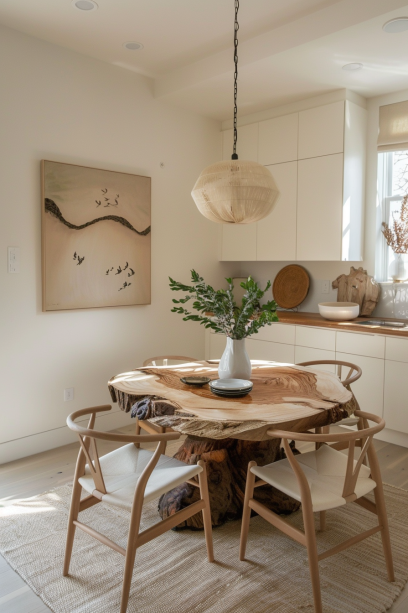
2. Sleek and Modern Minimalism
A Touch of Nature in Modern Spaces
A live edge wood dining table can simply make the perfect centerpiece for a modern dining room.

Pair it with metal or acrylic streamlined dining chairs to keep the lines minimal, and add a dose of organic naturalism.

The contrast between modern and natural elements creates a balanced and stylish atmosphere.



3. Space-Saving Live Edge Tables
Maximizing Functionality
Space-saving dining rooms tables with live edge are a lifesaver for those working with little space.

Consider tables with drop leaves or extendable options to provide flexibility without compromising style.

Combine multifunctional furniture, such as benches with storage under the seats, to maximise the functionality of your dining area.


4. Rustic Elegance with Bench Seating
Embrace Natural Aesthetics
One could create a cohesive rustic appearance by including a live edge dining table with bench seating.
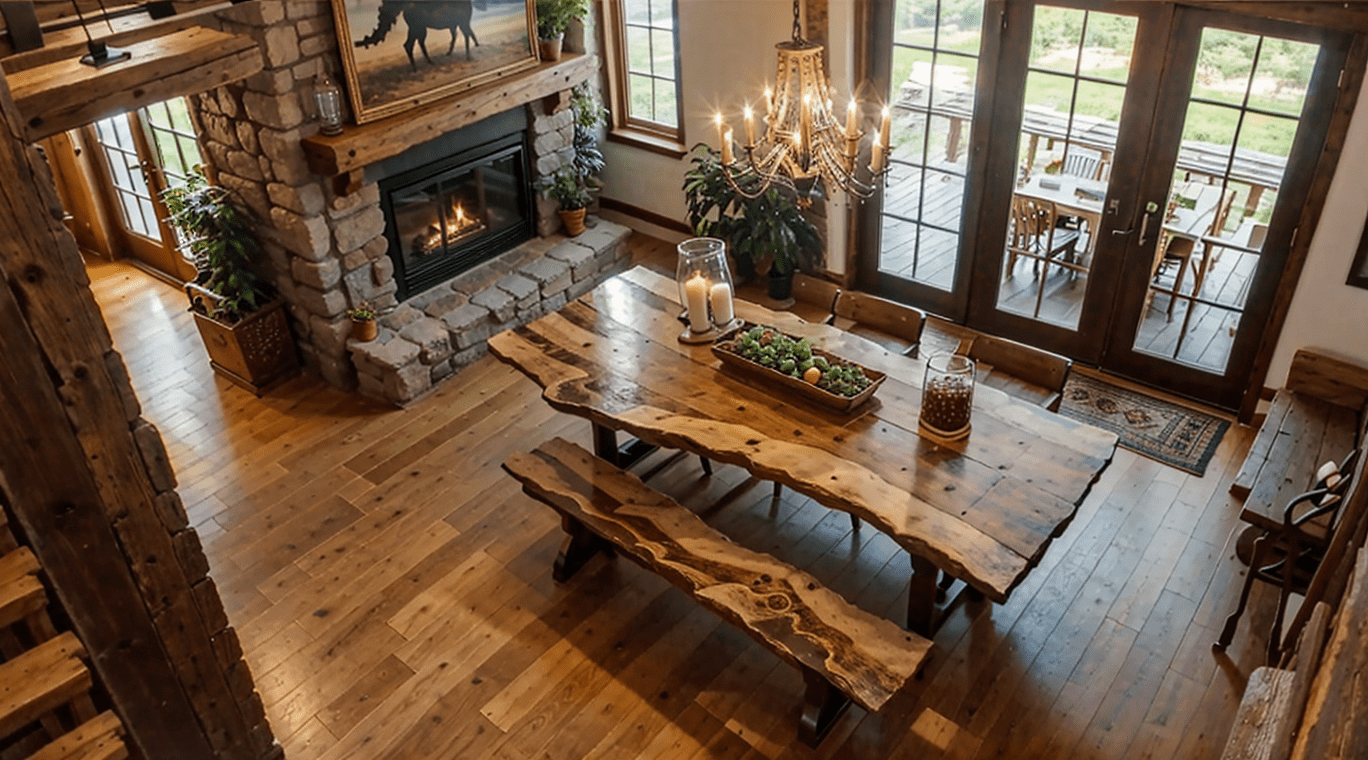
The benches follow through on the organic flow of the table’s live edge, keeping the whole composition in harmony.


It works especially well with a farmhouse or rustic aesthetic, and pairs function and beauty in one.



5. Mixed Wood and Metal Design
Industrial Charm Meets Organic Beauty
There is room for creativity when quests for a stunning contrast between wood and metal as highlight of your live edge dining table design.
Combine the stability and slightly industrial feel of a metal leg or base structure and a wood tabletop, and live edge wood might be the perfect material to achieve that look.

This is perfect for loft or industrial-themed homes.

6. Custom Shapes and Unique Designs
Crafting One-of-a-Kind Pieces
Embrace the unique qualities of the wood by featuring custom shapes and designs.

It can also be manufactured in any size to meet your home decorations and space requirements.
A custom wood dining table with live edge wood design can meet your different needs.

That way, no two tables are exactly alike, each piece of wood celebrating its difference, unique.



7. Subtle Sophistication with Glass Accents
Combining Transparency and Texture
For a sophisticated twist, consider adding glass elements alongside the live edge wood.

A live edge dining table with a glass top will maintain the natural beauty of the wood and add a contemporary flair to your dining experience.

This combination works well in modern and classic dining interiors.


8. Perfect Pairings: Live Edge and Upholstered Chairs
Softening the Raw Edges
Pair your live edge dining table with upholstered chairs to create a cozy and inviting dining space.

The soft texture of the upholstery can balance the raw edges of the wood, offering comfort and style.

This approach is ideal for those who love mixing traditional elements with nature-inspired designs.




9. Outdoor Live Edge Dining Tables
Bringing Inside Comfort Outside
Don’t forget that a live edge dining table can be used outdoors. It will help you in creating a truley magical outdoor dining ambience.

Go with waterproof finishes and match it to outdoor seating with designs that accentuate the wood’s natural beauty.

Perfect for garden parties or serene outdoor breakfasts.
10. Live Edge Bar-Height Tables
A Casual and Relaxed Dining Option
Create a more relaxed dining experience with a live edge bar height table – a nice complement to a casual dining area or breakfast bar.


Pair with sleek bar stools for an informal-but-refined setting conducive to speech and camaraderie.

11. Pendant Lighting Accents
Enhance Ambiance and Focus
Match your live edge dining table with pendant lighting for a focal point in your dining room.


Find light fixtures that complement the tone of your natural wood and give you enough illumination that you can appreciate the beauty of your live edge table top’s grain and texture.

This setup enhances the ambiance, particularly in evening settings.
12. Multi-Toned Wood Designs
Embracing Varied Textures and Colors
A multi-toned live edge dining table can add striking visual interest to your dining space.
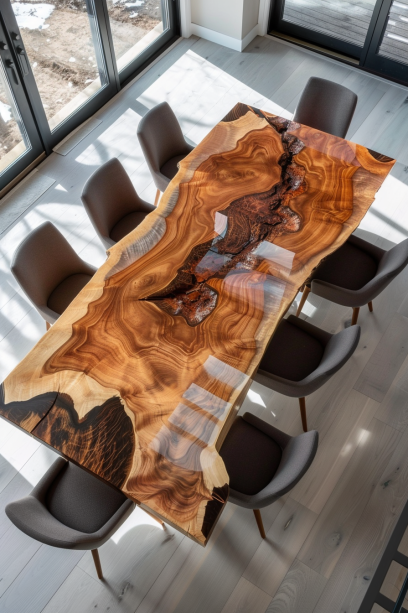
Instead, choose forms that have included woods of different hues and textures side by side, a patchwork of timbers.


This treatment embraces the variety of natural wood.
13. Live Edge Tables with Epoxy Resin
Artistic Infusion with Resin
You could go all in with a live edge dining table featuring epoxy resin inlays.
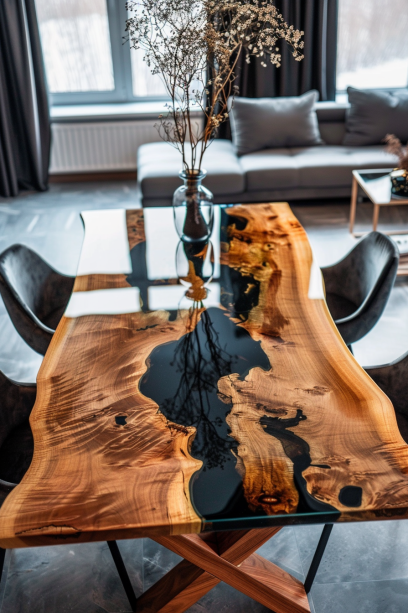
The resin fills the natural cracks and hollows in the wood, adding colour or en join the colours with a glinting river-like effect running down the centre of the table.

This method combines the raw beauty of wood with artistic craftsmanship.


14. Floating Live Edge Tables
Creating Illusion of Space
Using a live edge floating dining table that is nailed into the wall doesn’t take extra space, it makes it seem airier and more modern.

The benefit of this style is that it’s great for small spaces, or for minimalist interiors. It’s practical without being at the cost of style.

15. Pair with Rug for Texture Contrast
Layering Textures for Comfort
Pair your live edge dining table with a textured or patterned rug to provide contrast and comfort underfoot.

The rug draws the dining zone from the centre of the room and anchors the space, especially in a hybrid room – though it could be on any floor.
Lastly, it warms the most conspicuous natural element in the room, the live edge furniture.

Pick a rug that goes well with the wood tones and other colours in your walls, floors and furniture.

Incorporating Benches
Live edge dining tables make for a popular combination with benches. This combination is multipurpose and allows a coveted combination of function and beauty in dining spaces.
Here, we’ll go over some of the benefits of benches, as well as the different design styles you can choose from when selecting one that goes well with your live edge dining table.
Dining Table with Bench
Cohesive Design:
Unified look: Benches provide clean, simple lines that nicely contrast with the more organic, natural styling of live edge tables, establishing a balanced, unified aesthetic.


Versatile Design: Benches can be tailored to fit different styles, including rustic, farmhouse or contemporary and minimalist, improving the interior decoration.
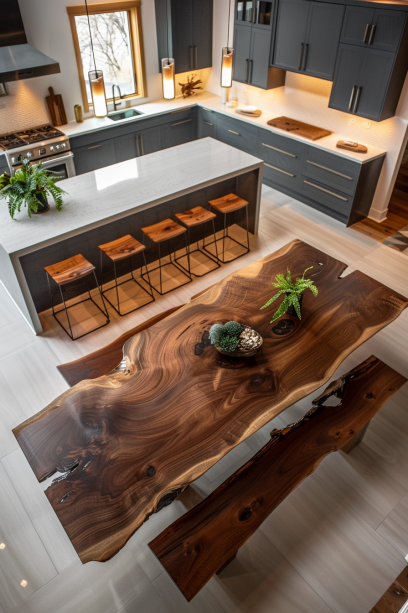

Space Efficiency:
Compact Seating: benches will in general seat more people than chairs, which makes them an excellent option for smaller rooms, or for when you are occasionally in need of extra seating.


Clean Storage: A lot of benches can be stacked up neatly and slid underneath the table when not in use, to save up floor space and also make the dining room look more spaced.

Communal Feel:
Social Dining: Benches encourage a communal and social dining experience. Sitting side-by-side fosters closer interaction and a sense of togetherness.
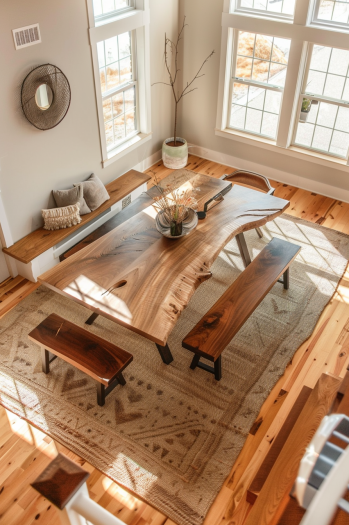
Wheelchair-accessible: Benches are often easier for families with young children or for visitors with wheelchairs or difficulties walking, such as older members of the family or an elderly visitor, to slide into and out of than individual chairs.

Design Variations
With a live edge dining table, it’s important to accompany it with a bench that matches you and your living style; the bench you choose should also fit in with the general decor of your living space.
There are many different styles and designs to begin with. Here are just a few:
Backless Benches:
Minimalist Appeal: These benches’ simple, unobtrusive design allows the wood to take centre stage with its natural edge and grain patterns.
Versatility: Backless benches can be easily moved around and used in different areas of the home, such as entryways or at the foot of the bed.


Benches with Backs:
Backrest-equipped: With a backrest, this bench offers more support, making it ideal for long meals and other gatherings.
Design Rationale: This style can add more formality and structure to your dining space. It often works well with traditional or transitional decor.

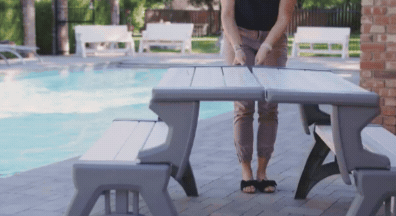
Cushioned Benches:
Increased Comfort: The padded chairs create a more comfortable eating environment, especially on longer meal occasions.

Customisation: A pair of cushions dressed up in a fabric of your choice is a versatile way to personalise the bench to the colour scheme and style of your dining room.


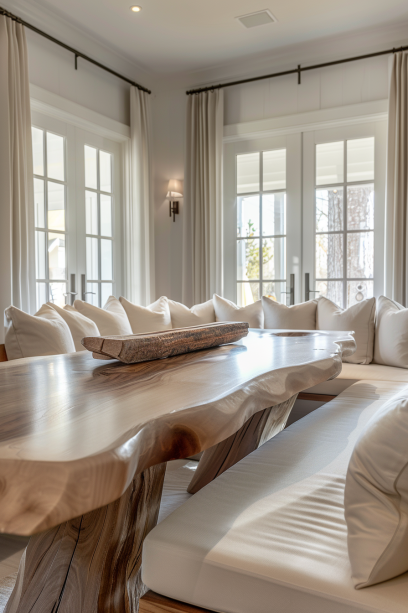
Wooden Benches:
Rustic Charm: Nothing pairs better with a live edge dining table than a wood bench, preferably showcasing the natural grain and texture of its chosen species.

Durability: Solid wood benches are sturdy and durable, ensuring long-lasting beauty and functionality.

Upholstered Benches:
Sophisticated Touch: Upholstered benches in high-quality fabric or leather bring a dollop of luxury to the dining area.
Colour and Pattern Opportunities: Upholstery provides the opportunity to add colour, pattern and texture to the room and ultimately enhance its visual stimulation.
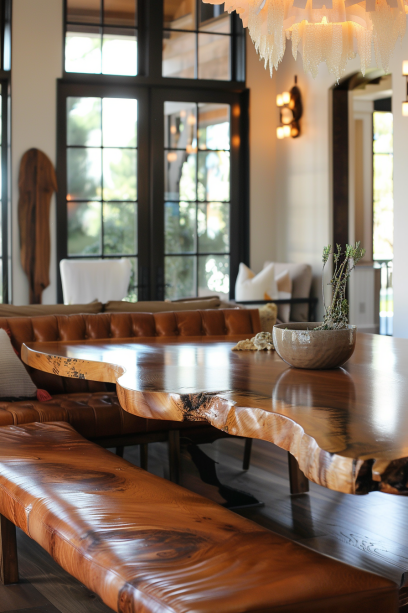

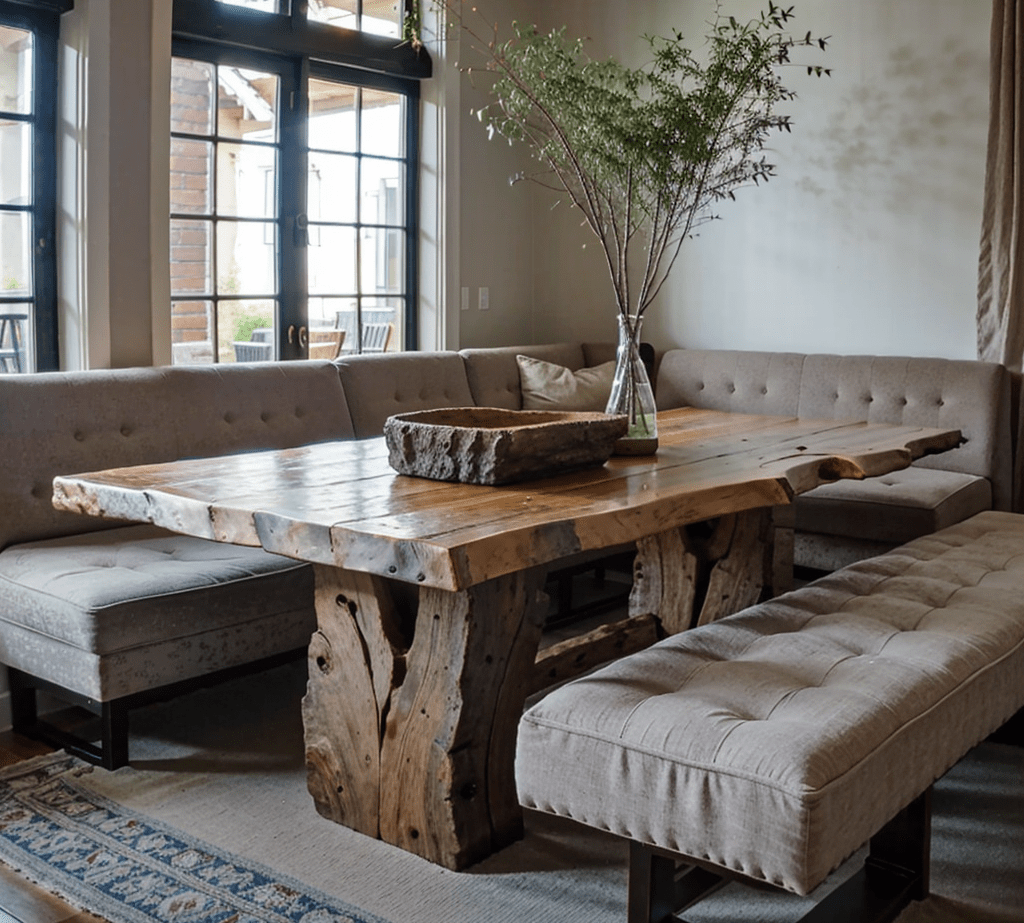
Industrial Benches:
Mix of Materials: Wood and metal come together in an industrial-style bench.
Modern Edge: These benches can add a contemporary and urban flair to your dining space, aligning well with modern interiors.

Space Considerations
Live edge dining tables can make a powerful design statement for any dining room, bringing nature and soul to the dining area.
But finding the appropriate live edge dining table for the size of your dining area is crucial, especially if you have a small dining area.
Below we provide design tips for choosing live edge dining tables in a small dining room, and also offer tips on dining rooms arrangement to optimise space usage.
Small Dining Room Solutions
Measuring Your Space:
Get Dimensions Right Off the Bat: First, measure the length, width and height of your dining space, as well as any architectural features such as windows, doors or alcoves that affect furniture placement.

Dining table clearances: Make sure that there is 36-48 inches of space on all sides of the table for clearance for movement and seating. This way, the dining room won’t feel too crowded, and getting to and from the table will be easy.

Choosing the Right Size:
Table Size: Choose your live edge table that fits best into the dimensions of your dining room.
For smaller spaces, look for a table approximately 60-72 inches long and 36-40 inches wide – about standard sizes for dining spaces, usually seating up to 6 comfortably.
Shape: The most space-efficient choices for small dining rooms are rectangular or oval-shaped tables. Elongation of a table enables you maximise the use of space better than square or round shapes.

Compact Seating:
Benches and slim chairs: Use benches or slim-profile chairs that slide under the table when not in use to keep your floor space as open as possible.
Multitasking Furniture: Use benches that can double up as a seat for other areas of your house when not used at your dining table.

Space-Saving Tips
Multifunctional Live Edge Tables:
Storage Underneath: Opt for live edge tables with added storage as an integral or secondary feature, such as a drawers or shelving built beneath the tabletop for storing linens, cutlery or even small kitchen appliances.

Convertible Tables: Tables of the live-edge variety are available on casters – that is, they can extend and retract as needs are determined.
They can permanently remain small for daily use, then be enlarged to display appreciation to house guests.
Optimized Layouts:
Placing the live edge dining table against a wall or in a corner can open up more room in the middle of the space for walking around and other actions.


Angled Set Up: Angling the table rather than placing it perpendicular to the walls of the room can make a space feel more conducive to flow and improve the perception of its size in a small room.

Lighting and Decor:
Storage: Go Vertical – Use shelving or storage units that can go up rather than out to save valuable square footage. Shelving units or tall, narrow cabinets can store dining essentials without using up too much of the valuable footprint of the room.

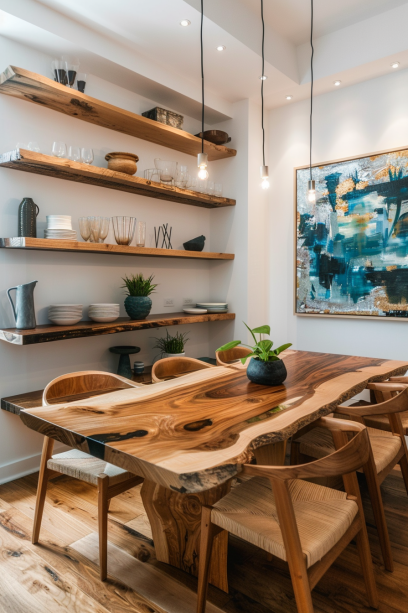
Light: Adequate lighting can make the room feel larger and more spacious. Layer in plenty of ambient light with hanging lights (such as pendants or chandeliers) directed towards the ceiling, where they will naturally draw the eye upward and emphasise vertical space.

Reflective Surfaces:
Mirrors: Placing a mirror opposite a dining table with a live edge can create a similar effect of light reflections in the natural edge design, double the landscape view, create more depth, and make the room appear bigger.


Glass Elements: Install a glass-topped sideboard or feature some glass decoration that will help to keep the space light and airy.

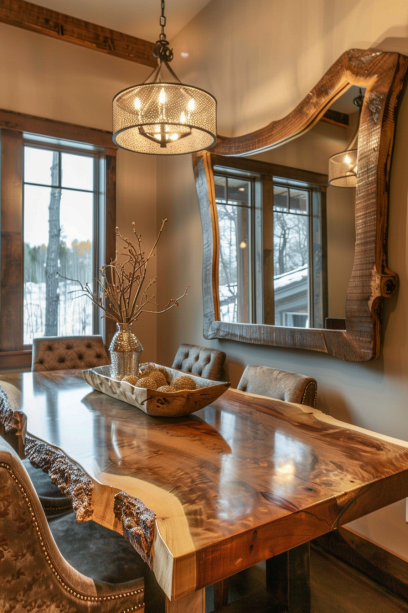
Maintenance and Care
Cleaning Tips
- Normal Dusting: Dust your live edge dining table once in a while with a soft, dry cloth to avoid build up of dirt.
- Mild detergent cleaning: using a sponge and little mild soap solution let the surface dry on it own. NEVER use harsh chemical to clean the sculpture. You will destroy the piece.
- Immediate Spill Cleanup: Quickly wipe up any spills to prevent staining and water damage.


Protection and Preservation
- Protective Coatings: Apply a commercial, wood sealant or natural oil finish once a year to protect the surface from moisture and wear.
- Coasters and Placemats: For drinks Use coasters on wood and plastic tabletops and placemats on laminate countertops to prevent rings and heat damage.
- Out of the direct sun: You should avoid placing the table in direct sunlight to prevent the wood from fading or drying out.

By following these simple tips, you’ll be able to keep your live edge dining table looking great and maintain it for a long time to come.

